Biologists use the fluid mosaic model to describe membrane structure. Which statements about the fluid mosaic structure of a membrane are correct? Select the three correct statements.
A. Because membranes are fluid, membrane proteins and phospholipids can drift about in the membrane.
B. The framework of a membrane is a bilayer of phospholipids with their hydrophilic heads facing the aqueous environment inside and outside of the cell and their hydrophobic tails clustered in the center.
C. The diverse proteins found in and attached to membranes perform many important functions.
D. The kinky tails of some proteins help keep the membrane fluid by preventing the component molecules from packing solidly together.
E. Membranes include a mosaic, or mix, of carbohydrates embedded in a phospholipid bilayer.
Answer: A, B & C.
A. Because membranes are fluid, membrane proteins and phospholipids can drift about in the membrane.
B. The framework of a membrane is a bilayer of phospholipids with their hydrophilic heads facing the aqueous environment inside and outside of the cell and their hydrophobic tails clustered in the center.
C. The diverse proteins found in and attached to membranes perform many important functions.
You might also like to view...
Oxygen compounds toxic to pathogens include
A) hydrogen peroxide. B) hypochlorus acid. C) nitric oxide. D) hydrogen peroxide, hypochlorus acid, and nitric oxide.
Bacteria and protozoans are ____
a. multicellular organisms b. unicellular organisms c. both unicellular and multicellular organisms d. the sole organisms of the oceans e. precursors to cells
The theory illustrated in Figure 21-1 is supported by which piece of additional evidence?

a. The results of the Miller-Urey experiment.
b. Burgess shale fossils.
c. Ediacarian fossils.
d. The presence of DNA in some organelles.
e. All answers support the illustrated theory
Which of the following organisms is photoautotrophic protozoan?
A) oomycote B) cellular slime mold C) Euglena D) Phytophthora E) plasmodial slime mold